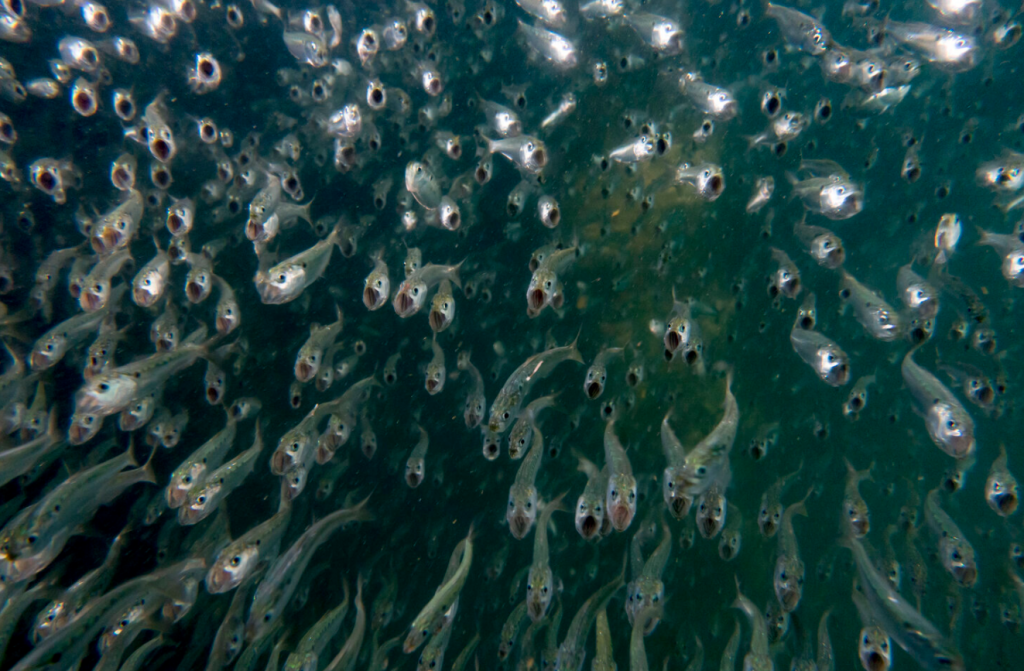This is a dispatch from Long Island Soundkeeper Bill Lucey

In November of this year the Sound was full of menhaden. By full I mean we had reports of huge, continuous schools from the Bronx all the way to Watch Hill and over to the North Fork of Long Island and back down to Hempstead Harbor. Our colleagues at Riverkeeper also reported large numbers in the New York Harbor and Hudson River Estuary. During the earthquake we had in early November a friend of mine was fishing by Watch Hill and described “millions” of bunker jumping out of the water simultaneously, sounding like a massive waterfall when they came back down.
This abundance is a testament to management actions currently being undertaken by the Atlantic States Marine Fisheries Commission. Since 2012, the ASMFC has placed quotas on how many fish can be harvested. Furthermore, in August, CTDEEP led the charge on passing a quota level determined by an ecosystem based approach to fisheries management. I have written before about this effort, which essentially provides an abundance of menhaden for other species in contrast to single species management which is focused on human harvest.
Forage fish are inherently difficult to manage since they react quickly to changing ocean conditions. It is important to keep a healthy biomass out there swimming around to maximize the flexibility of the population to adjust to these changing conditions. When conditions are excellent and forecasts are strong the fishing community can increase their harvests. When the opposite is true they can back off to allow the population a quicker recovery.
The current die-off has been noticed far and wide. We have had many questions so this is what we know:
The CT Fisheries Advisory Committee (FAC) had a meeting in which we asked questions about this directly to both the Marine Fisheries Director and the overall DEEP Fisheries supervisor. They have also been getting a lot of calls. Here is a link to DEEP’s findings.
To reiterate, we saw a gigantic number of menhaden in Long Island Sound this fall. One theory is that many of the fish missed a migration cue, which may have been due to warmer water temperatures.
With that many fish in the Sound there could have been an issue with plankton availability, which naturally decrease this time of year as well and, as the temperatures got colder, they were not getting enough food. The weaker ones may have succumbed to both less food and colder water. However, many of the fish seem to have moved out now and are now headed south. Traditional spawning grounds in late autumn are typically off the Carolina coasts, but the climate is changing and seems to be affecting the normal movements of many species. Recent research has also indicated that a third of the Atlantic menhaden population may now be originating in Southern New England waters instead of farther south.
I have noticed that the remaining bunker at Captain’s Cove Seaport are sluggish in the colder water. The gulls are having a field day and are constantly dropping them on the dock so they can dine at will. Many of the fish on shore may be ending up there in this way.
The main takeaway is that menhaden are the most abundant stock out there and they are in excellent shape as far as population size. Additionally, quota reductions and the recent passage of ecosystem based management targets for this species are geared to increasing the biomass of menhaden for other species such as striped bass and bluefish. Even non-fish species such as eagles, ospreys, whales and seals will benefit to greater prey abundance.
These fish kills are seen along the entire Connecticut coastline as well as into New York waters. However, the sheer number that are still swimming around in places like Black Rock Harbor, Bridgeport illustrate pretty clearly that the mortality rate is likely very low compared to the overall population and the die-offs are natural given the environmental conditions. My guess is that we will be seeing more dead fish in the coming days.
This synopsis is theoretical – we really don’t know yet why this is happening. A wild card is a pathology study ongoing with NYS DEC looking for potential viruses or other disease. The results have not yet been released but we will update this information when it becomes available.
Further Reading
CT Examiner interview featuring myself and David Molnar, DEEP Fisheries Biologist.
I was interviewed in a brief WSHU-NPR piece on the subject.
Bill Lucey, Long Island Soundkeeper
